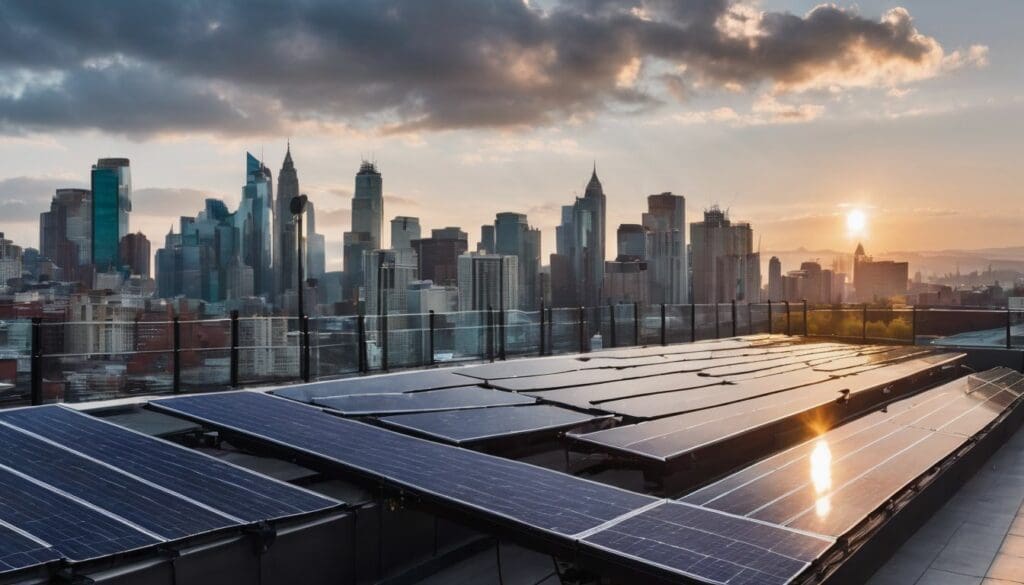Energy bills are rising and the planet is warming up. By 2025, renewable energy will power one-third of global electricity. Our blog looks at upcoming trends that could change how you use and save energy.
Dive in for an energised future!
Key Takeaways
- China is at the forefront of renewable energy, targeting nonfossil sources for a large part of its energy mix by 2030 and leading in solar panel production.
- Offshore wind energy plays a crucial role in global electricity generation, with advancements making it more viable and central to sustainable energy solutions.
- The transition to renewable resources includes challenges such as high initial costs and the need for grid integration improvements but promises long-term environmental benefits.
- Solar power stands out as a leader in renewables due to decreasing costs and enhanced efficiency, supporting individual and community energy independence.
- Biofuels remain popular as an eco – friendly alternative to fossil fuels, with continuous advancements expected to boost their demand further.
China Leading the Way in Renewable Energy
China has become a powerhouse in renewable energy, quickly outpacing other nations with its commitment to clean power. The country is now the world’s largest producer of solar panels, and it has an ambitious plan to continue expanding its renewable capacity.
Massive investments in solar and wind power have made China a global leader in both industries.
In addition to generating electricity from the sun and wind, China is exploring new frontiers in renewable resources. It prioritises sustainable energy development and aims for a significant portion of its energy mix to come from nonfossil sources by 2030.
This drive towards renewables not only supports global climate change efforts but also positions China at the forefront of green technology innovation.
Looking beyond just solar panels and turbines, China is setting benchmarks with projects like constructing vast hydroelectric dams and experimenting with emerging technologies such as green hydrogen—a potential game-changer in clean energy transition.
Its efforts extend across borders too, financing numerous renewable projects worldwide.
As we witness these extraordinary steps forward, it becomes clear that the expansion of offshore wind energy represents another thrilling chapter in our journey towards an environmentally-friendly future.
Expansion of Offshore Wind Energy
Offshore wind energy is a rapidly growing sector in the renewable energy industry. It offers vast potential for electricity generation and contributes significantly to nonfossil energy sources.
Clean energy technology has advanced, making offshore wind farms economically viable and essential for global electricity generation. As new energy sources emerge, the expansion of offshore wind power is projected to play a key role in meeting energy demands sustainably.
Moreover, with ongoing research and development in green technologies, carbon-neutral alternative energy solutions are on the rise. Offshore wind farms provide an opportunity for environmentally conscious individuals to support conservation efforts while contributing to global electricity generation.
Embracing offshore wind energy will be crucial in shaping the future of renewable deployment and ensuring a cleaner, more sustainable environment for generations to come.
Continued advancements in this field hold promise for further reducing reliance on fossil fuels and combating climate change by harnessing the power of natural resources like never before.
Challenges and Costs for the Future of Renewable Energy
Developing and integrating renewable energy sources comes with several challenges. One key challenge is the high initial costs associated with building and installing renewable energy infrastructure.
Alongside this, the intermittency of some renewable sources, such as wind and solar power, poses a challenge for maintaining consistent energy supply to meet demand. Additionally, grid integration and storage technologies need to be improved to accommodate the fluctuating nature of renewable energy sources.
Overcoming these challenges requires innovation and investment in research and development to drive down costs while enhancing efficiency.
Furthermore, transitioning from traditional fossil fuels to renewables may entail workforce reskilling – ensuring that professionals in the industry are equipped with the necessary expertise to work effectively within this evolving landscape.
As we navigate these hurdles, it’s essential to recognise that despite these challenges, investing in renewable energy offers substantial long-term benefits by reducing greenhouse gas emissions and minimising our reliance on finite resources.
Dominance of Solar Energy
Overcoming the challenges and costs of renewable energy, solar power emerges as a dominant force in the global energy landscape. Solar energy continues to gain momentum owing to its affordability, scalability, and sustainability.
The technology’s potential for decentralisation empowers individuals and communities to generate their own clean energy, reducing reliance on traditional grid systems.
As solar technology advances and becomes more efficient, it is expected to play an increasingly significant role in achieving carbon-neutral goals. The widespread adoption of solar panels on residential and commercial properties signifies a shift towards a future where sustainable energy sources are at the forefront of meeting our global energy needs.
Continued Demand for Biofuels
Biofuels continue to be in high demand as a sustainable alternative to traditional fossil fuels. The push for cleaner energy sources and the need to reduce greenhouse gas emissions has led to an ongoing interest in biofuels across various industries.
With a focus on carbon neutrality and energy efficiency, biofuels are expected to play a significant role in the future of renewable energy. As the industry continues to evolve, advancements in technology and production processes will further drive the demand for biofuels.
As global efforts intensify towards promoting environmentally friendly practices, the continued demand for biofuels signifies a positive shift towards a more sustainable and eco-friendly future.
Growth of Energy Storage and Reskilling the Workforce
Continued Demand for Biofuels shows that the future of renewable energy is promising, with the growth of energy storage and the need for reskilling the workforce becoming increasingly important. Here’s what you need to know:
- Energy Storage Innovations: Advancements in battery technology and grid-scale energy storage solutions are crucial for storing surplus renewable energy.
- Importance of Grid Flexibility: With a fluctuating supply from renewable sources like solar and wind, flexible grid management is essential for reliable energy supply.
- Reskilling the Workforce: The transition to renewable energy requires a skilled workforce adept at new technologies and sustainable practices.
- Job Opportunities in Energy Storage: The growing demand for energy storage systems presents new career opportunities in manufacturing, installation, and maintenance.
- Integration with Electric Vehicles (EVs): Energy storage plays a key role in supporting the expansion of EVs by enabling efficient charging infrastructure.
- Role in Carbon Neutrality: Effective energy storage contributes to achieving carbon-neutral goals by ensuring consistent clean power availability.
- Challenges and Research Initiatives: Research into cost-effective, durable, and environmentally sustainable energy storage methods is ongoing to meet future demands.
Conclusion: Are You Ready to be a Part of the Future of Renewable Energy?
Are you prepared to be part of the future of renewable energy? The global energy landscape is shifting towards sustainability. Renewable energy sources are becoming more accessible and cost-effective.
It’s time to embrace the opportunities that come with this green revolution. Will you be a part of shaping the future of renewable energy? Join us on this journey towards a greener, more sustainable world.
FAQs
1. What are future trends in global renewable energy?
The future trends in global renewable energy include a shift towards greener sources, an increase in carbon-neutral projects, and advancements in technology to meet rising energy demands.
2. How will energy projections influence the energy industry outlook?
Energy projections that focus on sustainability and renewable sources will steer the industry outlook towards more eco-friendly practices and innovations for cleaner power generation.
3. Can we expect renewables to dominate future energy trends?
Yes! As technology advances and government policies support green initiatives, it’s likely that renewables will play a bigger role and potentially dominate future energy trends.
4. Will achieving a carbon-neutral status impact the way we use energy?
Definitely! Striving for carbon neutrality means developing new ways to produce, store, and consume energy without adding greenhouse gases into the atmosphere—it’s set to transform our daily usage of power significantly.





